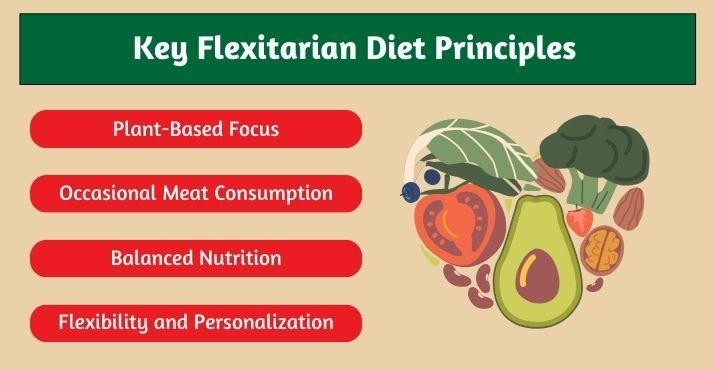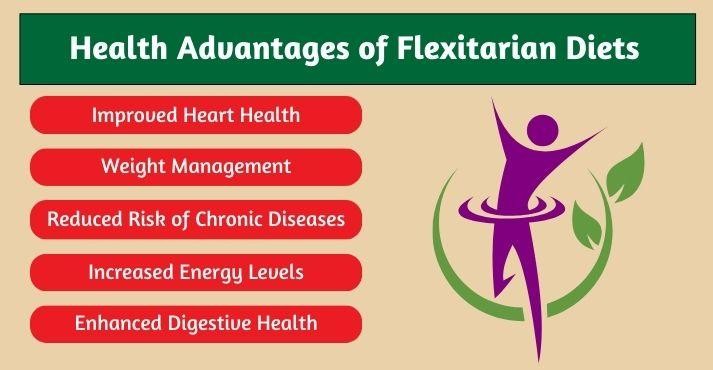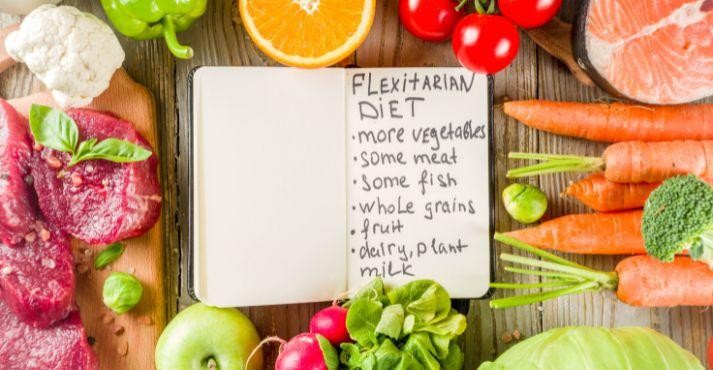Have you heard of the flexible eating style gaining popularity for its health benefits and eco-friendliness? Known as the flexitarian diet, this approach blends primarily plant-based foods with occasional meat, balancing vegetarianism and traditional diets.
The term combines “flexible” with “vegetarian,” emphasizing choice and flexibility. Many people are drawn to this semi-vegetarian style because it supports better health and aligns with sustainable eating habits, making it an accessible option for those wanting to eat more mindfully.
With the rise in awareness about environmental impacts and health concerns, more individuals are looking for dietary options that don’t require giving up meat entirely but still allow for healthier choices.
Let’s explore a flexitarian diet and why it might be the right choice for you.
What is a Flexitarian Diet?

A flexitarian diet is an eating style that combines the principles of vegetarianism with occasional meat consumption.
It encourages eating primarily plant-based foods like vegetables, fruits, grains, and legumes while allowing for moderate meat or animal product intake. This diet offers a structured yet flexible approach to reducing meat without eliminating it.
Dietitian Dawn Jackson Blatner first coined the term “flexitarian” in 2008 when she published a book outlining the basics of the flexitarian diet.
Unlike strict vegetarian or vegan diets, flexitarianism allows for individual preferences, making it an appealing choice for people who want to enjoy the benefits of a sustainable diet without feeling restricted.
Key Principles of a Flexitarian Diet

The flexitarian diet is built around a few core principles that make it easy to follow while promoting a healthy, balanced lifestyle.
1. Plant-Based Focus
One of the main principles of a flexitarian diet is a strong focus on plant-based foods. These include vegetables, fruits, whole grains, legumes, nuts, and seeds.
When emphasizing these nutrient-dense options, flexitarian eaters consume meals naturally rich in vitamins, minerals, and antioxidants.
Traditional vegetarian dishes inspire many flexitarian meals, yet they allow the addition of small amounts of meat or animal products as desired. For example, a flexitarian may enjoy a veggie stir-fry with tofu or occasionally add plant-based meat or lean chicken.
2. Occasional Meat Consumption
Unlike vegetarian or vegan diets, which eliminate meat entirely, the flexitarian diet allows occasional meat intake. This approach provides flexibility for those who don’t want to give up meat entirely but are committed to reducing their consumption.
This flexibility can include plant-based seafood or alternatives that mimic animal-based products while supporting dietary goals. People might eat meat only on weekends, for special events, or in smaller portions than in a typical omnivorous diet.
The goal is to reduce meat consumption significantly but allow it in moderation, which helps make the diet more adaptable to individual preferences.
3. Balanced Nutrition
The flexitarian diet plan ensures a balanced intake of nutrients. When combining various food groups, this diet promotes a well-rounded protein, fiber, and essential vitamins intake.
Plant-based foods like lentils, beans, and nuts provide protein, while whole grains and vegetables add fiber, supporting overall health.
For those including animal products, choosing high-quality, nutrient-dense options like hybrid meat or organic dairy can help improve the nutritional balance of each meal.
4. Flexibility and Personalization
A unique feature of the flexitarian diet is its adaptability. Individuals can personalize their eating plan based on health goals, taste preferences, and lifestyle needs.
This flexibility makes it easy for people to transition into a semi-vegetarian approach without feeling restricted.
Flexitarianism allows for a tailored approach, enabling people to choose which meals to make entirely plant-based and when to include small amounts of meat or fish, which keeps the diet manageable and enjoyable.
Health Benefits of a Flexitarian Diet

The flexitarian diet has numerous health benefits, making it an appealing choice for those seeking a nutritious and balanced lifestyle. Here are some of the significant health benefits that come with adopting a flexitarian diet plan:
1. Improved Heart Health
Reducing meat intake and focusing on plant-based foods can positively impact heart health. Plant-based foods are typically low in saturated fats, which helps lower cholesterol levels and support a healthy cardiovascular system.
Whole grains, fruits, and vegetables contain fiber and antioxidants, which are known to reduce heart disease risk. Studies have shown that diets with more plant-based meals can significantly lower blood pressure, promoting a healthier heart.
2. Weight Management
Many people find that a flexitarian diet helps with weight management. Since this diet encourages nutrient-dense foods high in fiber and low in calories, it can help individuals maintain a healthy weight.
Fiber-rich foods like fruits, vegetables, and whole grains promote satiety, meaning people feel full more extended and are less likely to overeat. The flexitarian diet supports a healthier body weight by limiting high-calorie meats and processed foods.
3. Reduced Risk of Chronic Diseases
A sustainable diet rich in plants and low in red meat can help reduce the risk of chronic illnesses such as diabetes, certain cancers, and obesity.
Research has shown that flexitarian meals contribute to lower rates of diabetes and can improve blood sugar levels, due to their high fiber content. By lowering red and processed meat intake, flexitarianism also reduces the risk factors associated with colorectal cancer.
4. Increased Energy Levels
Since the flexitarian diet includes a variety of nutrient-dense foods, it can boost energy levels. When consuming a balanced mix of carbohydrates, proteins, and fats, flexitarian eaters gain more sustained energy throughout the day.
Whole grains, legumes, and vegetables provide complex carbs that release energy slowly, preventing energy crashes and stabilizing blood sugar levels.
5. Enhanced Digestive Health
The flexitarian diet, with its emphasis on fiber-rich flexitarian meals, can improve digestive health. Fiber aids in digestion, supports healthy gut bacteria and prevents constipation.
By incorporating a variety of fruits, vegetables, whole grains, and legumes, flexitarianism supports a healthier digestive tract and overall gut health.
How to Transition to a Flexitarian Diet?
Starting a flexitarian diet can be easy and enjoyable with a few gradual steps. For those new to the concept, transitioning gradually by reducing meat consumption over time is recommended. Here are some practical tips to ease into a flexitarian lifestyle:
- Start with Meatless Days: Dedicate one or two days a week to eating only plant-based foods. This will help you become accustomed to semi-vegetarian meals without feeling restricted.
- Incorporate More Plant-Based Proteins: Replace meat with protein-rich foods like beans, lentils, tofu, and plant-based meat These options help ensure balanced nutrition and keep meals satisfying.
- Experiment with Recipes: Try different recipes with vegetables, whole grains, and legumes to add variety to your meals. This keeps the diet exciting and prevents boredom.
- Plan Ahead: Preparing a flexible flexitarian diet plan can make transitions smoother. Planning meals in advance helps balance food choices and ensures you have nutritious ingredients.
Foods to Include and Avoid In a Flexitarian Diet

The flexitarian diet food list focuses on whole, nutrient-rich foods while limiting certain processed items.
1. Recommended Foods
The staples of a flexitarian diet include:
- Fruits and Vegetables are essential for vitamins, minerals, and fiber.
- Whole Grains: Options like quinoa, brown rice, and oats provide complex carbs and fiber.
- Legumes: Beans, lentils, and chickpeas offer protein and fiber.
- Nuts and Seeds: These add healthy fats and protein to flexitarian meals.
- Occasional Animal Products: When included, choose high-quality options like grass-fed meat, wild-caught fish, or organic eggs.
2. Foods to Minimize
To follow a flexitarian diet effectively, it’s best to limit:
- Processed Meats: Items like bacon, sausages, and deli meats are often high in sodium and additives.
- Refined Carbohydrates: Foods like white bread, pastries, and refined grains should be consumed sparingly.
- Added Sugars: Avoid excessive sugary drinks and desserts, which offer little nutritional value.
Flexitarian vs. Vegetarian and Vegan Diets
The flexitarian diet stands out from vegetarian and vegan diets primarily because of its flexibility, reflected in its name—a blend of “flexible” and “vegetarian.”
This diet is ideal for people who want to focus on plant-based foods without completely committing to vegetarianism or veganism.
While vegetarians and vegans strictly avoid meat, and vegans exclude all animal-derived products, flexitarians maintain an adaptable approach, reducing but not entirely eliminating meat or animal products from their diet.
This difference can make the flexitarian lifestyle easier for those who prefer a balanced, middle-ground approach to eating.
The Vegetarian Diet
Vegetarian diets typically exclude all types of meat, including red meat, poultry, and fish, though many vegetarians still consume dairy products and eggs.
For instance, a lacto-ovo vegetarian diet includes these items, making it more flexible than veganism. It focuses on eating a variety of plant-based foods like vegetables, fruits, legumes, whole grains, nuts, and seeds.
Vegetarians often choose this diet for health reasons, environmental concerns, or ethical considerations related to animal welfare.
Like the flexitarian diet, a vegetarian diet aligns with a sustainable diet by reducing reliance on animal agriculture, linked to resource depletion and greenhouse gas emissions.
However, one significant difference is that vegetarians completely avoid meat, which can be challenging for those who want occasional flexibility.
The flexitarian diet is designed to be more adaptable. It allows people to enjoy the benefits of a largely plant-based diet while retaining the option to eat small amounts of meat, fish, or poultry when desired.
This flexibility makes it a good starting point for those exploring plant-based eating without the commitment required for vegetarianism.
The Vegan Diet
Veganism takes things a step further by avoiding all animal products, including meat, dairy, eggs, and often even honey. Vegans aim to eliminate animal-derived foods entirely, focusing on a diet rich in fruits, vegetables, grains, nuts, seeds, and legumes.
The vegan lifestyle is rooted in ethics and sustainability, as it aims to eliminate any form of animal exploitation. Vegan diets are also highly aligned with sustainable eating habits because they reduce demand for animal agriculture, which has significant environmental impacts.
However, the vegan diet can be quite restrictive for some people, requiring high commitment and careful planning to meet nutritional needs, particularly for protein, iron, vitamin B12, and omega-3 fatty acids.
In contrast, the flexitarian diet allows for the occasional inclusion of animal products, making it easier for people to meet their nutritional needs without strict supplementation.
Flexitarians enjoy more variety while contributing to a sustainable diet by reducing their reliance on animal products. This flexibility can also make social dining or dining out more convenient for those who may otherwise find it challenging to stick to vegetarian or vegan options in certain settings.
Why Flexitarianism May Be Easier for Some?
The flexitarian diet’s adaptability makes it accessible and sustainable for people who want to reduce their meat intake but are not ready to eliminate it entirely.
Flexitarianism offers the benefits of plant-based eating—like reduced risk of chronic diseases, lower environmental impact, and potentially improved health outcomes—without the feeling of restriction.
This diet is often seen as a balanced compromise, offering the freedom to make food choices based on individual needs, lifestyle, and cultural preferences. For many, it provides a bridge to explore plant-based eating while leaving room for occasional indulgences, making it an inviting and practical option today.
Conclusion
In summary, a flexitarian diet is a flexible, balanced approach to eating that promotes mostly plant-based foods while allowing moderate meat consumption.
This semi-vegetarian style is gaining popularity due to its health benefits, adaptability, and positive environmental impact.
If you’re looking to improve your health, support the environment, or simply enjoy a more varied diet, the flexitarian diet offers a practical and accessible way to do so.
Adopting this sustainable diet can be an enjoyable and impactful journey toward better health and well-being.





























